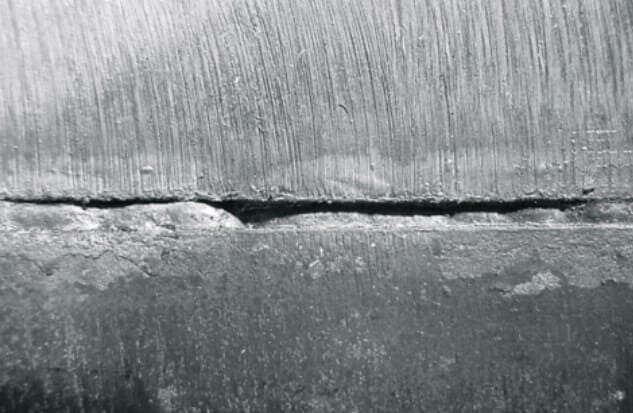Lack of fusion is a common welding defect that occurs when the weld metal does not fuse completely with the base metal or the previous weld layer. This can result in a weak joint that is prone to failure under stress or load. Lack of fusion can also reduce the corrosion resistance and notch strength of the weld metal.

In this article, we will explain what causes a lack of fusion in welding, how to detect it, and how to prevent it using proper welding techniques and equipment.
I. What Causes Lack of Fusion in Welding?
Lack of fusion can be caused by several factors, such as:
Incorrect welding parameters: If the heat input is too low, the weld will not melt and fuse properly with the base metal. The heat input depends on the welding current, voltage, speed, and electrode size.
Incorrect welding technique: If the welder does not hold the electrode steady and in the correct position, it can cause lack of fusion. The electrode should be held at a 90-degree angle to the metal and moved along the joint at a consistent speed.
Poor fit-up: If there is a large gap between the two pieces of metal, it can prevent direct contact and fusion between the weld metal and the base metal. The gap should be minimized by using clamps, jigs, or tack welds.
Incorrect weld preparation: If the weld surface is not clean and free of contaminants, such as scale, rust, oil, or dirt, it can interfere with the fusion process. The weld surface should be cleaned using a wire brush, grinder, or solvent before welding.
Mode of metal transfer: The mode of metal transfer refers to how the molten metal droplets are transferred from the electrode to the weld pool. Some modes, such as short circuit transfer in GMAW, can cause low heat input and lack of fusion.
II. How to Detect Lack of Fusion in Welding?
Lack of fusion can be detected using various methods, such as:
Visual inspection: This is the simplest and most common method of detecting lack of fusion. The welder can look for signs of lack of fusion, such as gaps, cracks, or porosity in the weld. However, this method may not be able to detect a lack of fusion that is hidden below the surface or at the root of the weld.
Dye penetrant test: This is a non-destructive test that involves applying a dye to the weld and then using a developer to see if any dye has penetrated into the joint. This indicates that there is a lack of fusion or other defect in the weld.
X-ray test: This is another non-destructive test that uses an X-ray machine to see if there are any voids or porosity in the weld. This can help to detect lack of fusion that is not visible to the naked eye.
III. How to Prevent Lack of Fusion in Welding?
Lack of fusion can be prevented by following some best practices, such as:
Use proper welding parameters: The welder should adjust the welding current, voltage, speed, and electrode size according to the type and thickness of the metal, the joint design, and the welding position. The heat input should be high enough to ensure complete fusion without causing excessive distortion or burn-through.
Use proper welding technique: The welder should hold the electrode steady and at a 90-degree angle to the metal. The electrode should be moved along the joint at a consistent speed and with a slight weaving motion. The arc length should be kept short and stable.
Use proper fit-up: The gap between the two pieces of metal should be minimized by using clamps, jigs, or tack welds. The gap should not exceed 1/16 inch for most metals. If there is a large gap, it should be filled with filler metal or bridged with multiple passes.
Use proper weld preparation: The weld surface should be clean and free of contaminants before welding. The welder should use a wire brush, grinder, or solvent to remove any scale, rust, oil, or dirt from the metal. The welder should also use an appropriate electrode type for the metal being welded.
Use proper mode of metal transfer: The mode of metal transfer should be selected according to the type and thickness of the metal, the joint design, and the welding position. Some modes that can provide high heat input and good fusion are spray transfer in GMAW and globular transfer in FCAW.
IV. Conclusion
Lack of fusion is a serious welding defect that can compromise the strength and integrity of the welded joint. It can be caused by various factors, such as incorrect welding parameters, technique, fit-up, preparation, or mode of metal transfer. It can be detected by visual inspection, a dye penetrant test, or an X-ray test. It can be prevented by using proper welding parameters, technique, fit-up, preparation, and mode of metal transfer.
If you are looking for high-quality welding equipment and solutions, you can check out Megmeet Welding, a leading manufacturer and supplier of welding machines, consumables, and accessories. They offer a wide range of products for different welding applications, such as MIG/MAG, TIG, MMA, Laser, and more. They also provide customized solutions and technical support for your welding needs. Visit the website to learn more about Megmeet Welding products and services.
Related article:
1. Welding Defects, Problems And Easy Solutions [2023]
2. Undercut Welding Defect: Causes, Prevention, and Repair
3. Tips for Troubleshooting Common MIG Weld Defects
4. How to Identify the 7 Most Dangerous Welding Defects?
5. How to avoid blow holes defect in submerged arc welding?




